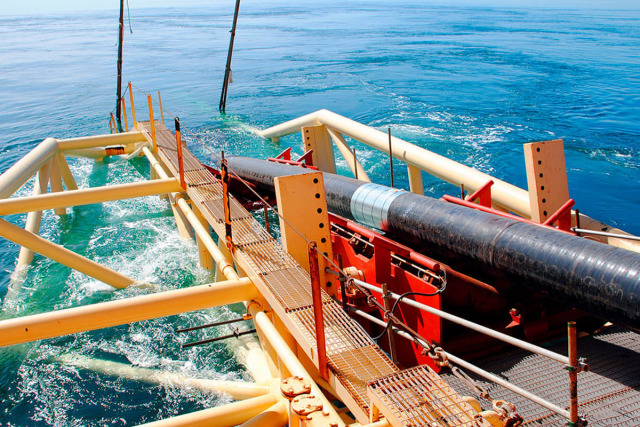The undermining of the Nord Stream-1 and Nord Stream-2 gas pipelines in the Baltic Sea has accelerated the implementation of plans in NATO and European countries to protect the national underwater infrastructure. The first part of the article revealed the plans of the war on the seabed of French and British strategists. This publication is devoted to the plans of Italian and German admirals.
Italian arsenal of warfare on the seabed
Developing a strategy of warfare on the seabed, Italy is working on a "National Underwater Cluster", which was created in accordance with the law on the national budget for 2023, approved in December 2022. Conceived as an interministerial structure, it will unite enterprises, universities, research institutes and centers under the control of the Italian Navy and the Italian Ministry of Defense to coordinate activities in the underwater sphere. The Italian Navy and the Ministry of Defense occupy leading positions in the field of research and protection of the dual-use seabed, including mine defense components and hydro-oceanographic vessels. More recently, they have included the management and staffing of NATO and Leonardo research vessels.
Having commissioned the Kongsberg Maritime HUGIN autonomous uninhabited vehicle (AUV) for dual-use operations in the early 2010s, after the accident on the Nord Streams, Italy intensified the survey of underwater infrastructures of national interest with the help of its fleet of minesweepers (MCMV). In July 2022, the Navy also signed an agreement with the Italian global network company Sparkle to improve the protection of underwater communication infrastructures through joint research and operational procedures.
In June 2021, the Department of Naval Armaments of the Italian Ministry of Defense (NAVARM) concluded with the shipyard T.Mariotti contract for the construction and equipment of a new special purpose ship and diving operations – a submarine rescue ship (special forces and diving operations– submarine rescue ship, SDO-SuRS) with a delivery date in 2025. In addition to the diving equipment and the rescue system for the crews of a new generation of submarines capable of operating at a depth of 600 m, provided by the oil and gas service company DRASS and Saipem, SDO-SuRS will be able to launch and lift deep-sea autonomous (AUV) and remotely operated uninhabited vehicles (ROV). The latter are provided by Saipem Sonsub.
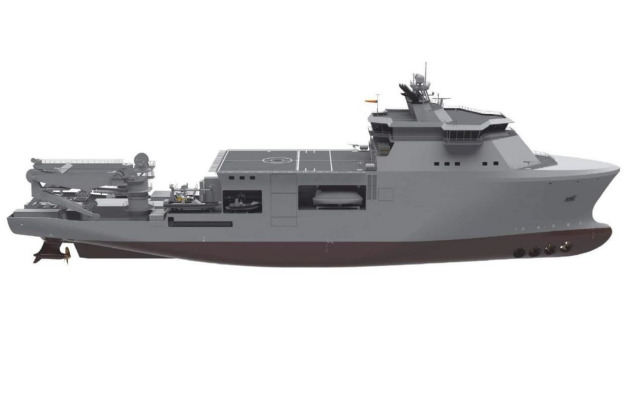
Sketch of the future underwater rescue ship of the Italian Navy SDO-SuRSIn February 2023, NAVARM signed a contract with Fincantieri for the construction of a new main hydro-oceanographic vessel (NIOM), which is scheduled to be delivered in 2026.
In addition to hydro-oceanographic equipment, the ship comes with deep-sea AUVs, uninhabited surface vessels (USVs) and unmanned aerial vehicles (UAVs) that can be used for Rapid Environmental Assessment (REA) missions. Meanwhile, the Italian Navy is increasing its fleet of 3,000-meter AUV HUGIN, as well as acquiring expeditionary capabilities from MCMV and other platforms. The Service, together with Intermarine and Leonardo, has also begun feasibility studies for both new offshore and coastal MCMVS equipped with a set of tools for using uninhabited platforms, along with coastal hydrographic vessels.
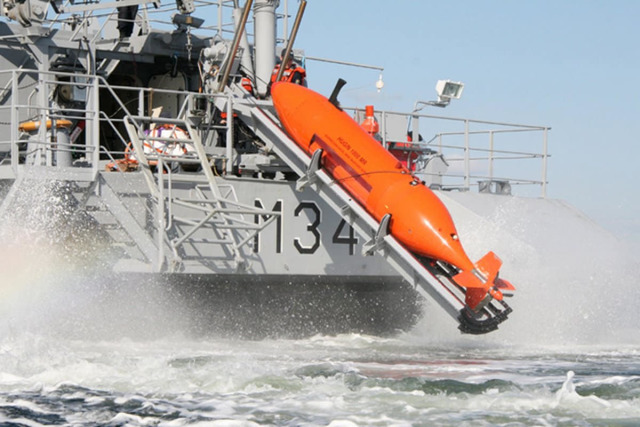
Autonomous uninhabited vehicle Kongsberg Maritime HUGINL3Harris Calzoni is leading a R&D program for an unmanned Marine Mine Warfare Capability (MCM) system based on USV with reconnaissance AUV and Expandable Mine Disposal Systems (MDS).
DRASS offers an open architecture of sonar and drones (Sonar and Drones Open Architecture, SDOA), which includes the installation on the seabed of a distributed infrastructure capable of acoustic detection in combination with other sensors and ROV/drone docking. Saipem offers its family of commercial working vehicles, including the Hydrone family of dual-purpose deep-sea vehicles (ROV/drone) and the AUV FlatFish. The latter is capable of reaching a depth of 3000 m with an autonomy of up to 12 hours. A smaller version with improved endurance and navigation characteristics is at the heart of the Italian Ministry of Defense's research and development program to evaluate potential applications in dual-use operations and in military operations.
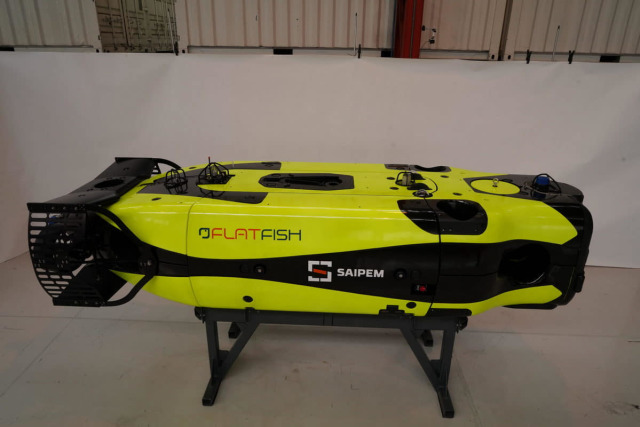 |
| Autonomous underwater vehicle FlatFish. |
| Source: invoen.ru |
The Italian Ministry of Defense has recently launched a market study on the integration of AUV with existing and future submarines (U212A/U212 NFS). As for uninhabited reconnaissance and operational underwater platforms, the Italian Ministry of Defense has unfunded financial needs for a large ocean-going uninhabited underwater vehicle (LUUV). Among the Italian companies specializing in the underwater sphere is Cabi Cattaneo, which provides a number of vehicles and equipment for special forces and diving units of the Italian Navy. DRASS, Leonardo, Gem Elettronica, Elettronica, Avio, Calzoni L3Harris and Fincantieri NexTech also work in this area, as well as Wsense.
The war on the seabed: a view from Germany
On March 15, 2023, the German Ministry of Defense published a document outlining the new structure of the Bundeswehr Navy forces by 2035 and beyond. The development of the fleet is based on the geostrategic security scenario and the threats that the German Armed Forces are expected to face. The main factors include the Ukrainian crisis, NATO expansion at the expense of Sweden and Finland, and events in the North Atlantic, North and Baltic Seas. Presenting future naval developments, the document notes how vulnerable the vital economic underwater infrastructure is due to the recent sabotage of gas pipelines in the Baltic Sea.
To cope with new surface, air and underwater threats and accelerate operations, the German Navy will have to become an integral part of national and Allied Multi-domain Operations (MDO). There is clearly a trend towards the use of unmanned systems that can be used in a network jointly involved by various branches of the armed forces.
According to the document, the underwater measurement is rapidly becoming increasingly important. To confront a potential enemy who can gain access to the area of interest long before the start of actual operations, the German Navy needs modern underwater sensor technologies — both stationary and mobile — along with AI-supported assessment capabilities in order to form and permanently preserve the tactical picture of the underwater situation. In addition, the fleet needs the means to ensure the ability to operate in offensive and defensive operations under water.
Regarding the proposed composition of the fleet, it is said that mine action, warfare on the seabed and reconnaissance missions will be conducted by 12 new mine-fighting ships that will replace Type 332 class platforms, as well as an undisclosed number of uninhabited MCM systems (for the first time in Germany). In addition to the purchase of six to nine new U212 CD submarines, the document announced the need for six LUUVS for reconnaissance operations. In addition, among the operational support platforms, the document lists three ships of the marine surveillance and reconnaissance project "Type 424" with a length of 130 m. Their construction and equipment was entrusted to NVL Group in June 2021.
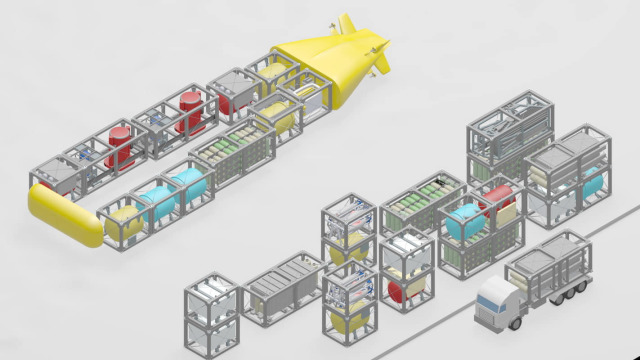
The project of the German underwater platform MUM from tkMSWithin the framework of the marine research program of the Federal Ministry of Economy and Energy of Germany, which supports innovative marine technologies, an industrial group led by thyssenkrupp Marine Systems (tkMS) is developing a breakthrough large platform, designated as a Modifiable Underwater Floating Base (MUM).
The platform will not only have to meet the various needs of the civilian maritime industry, but is also expected to receive military applications as well. The industrial group, including Atlas Elektronik, EvoLogics, the University of Rostock, the Technical University of Berlin, the Fraunhofer Institute, the German Aerospace Center and the Institute for the Protection of Marine Structures, should begin the creation and integration of systems in a 25-meter prototype in 2023.
According to tkMS, by the beginning of 2025, MUM should set a new standard for unmanned underwater operations. According to tkMS, the platform has a modular structure (including sections of transport containers measuring 3 m or 6 m) and a "flat fish" type structure in its wide part. Emission-free fuel cells and lithium-ion battery modules are used as the power plant and power source. MUM will be able to work 24 hours a day, 7 days a week, 365 days a year, regardless of wind and weather. She will be able to carry several small UUVs, ROVs and equipment for operations on the seabed. According to images published by tkMS, the modular design of the platform allows it to be used as a particularly large XLUUV for military purposes such as mine laying, anti-submarine warfare (ASW) or reconnaissance. The German company Atlas Elektronik also provided the Bundeswehr Navy with uninhabited surface vehicles of the ARCIMS, AUV SeaCat and MDS SeaFox families.
To be continued…
Based on the materials of the publication European Security & Defense
